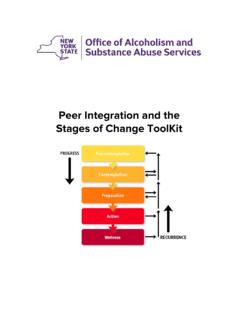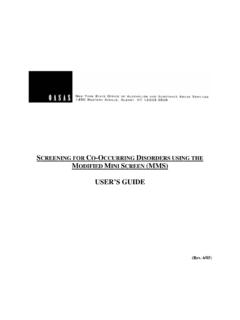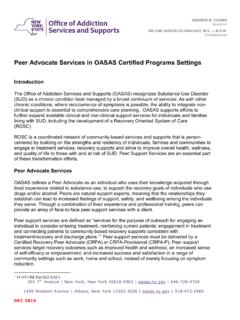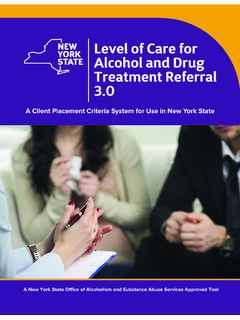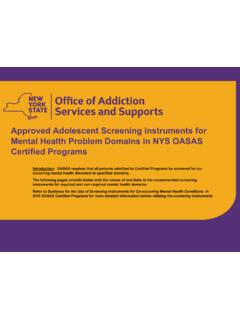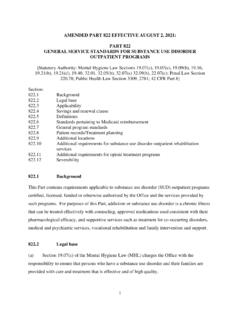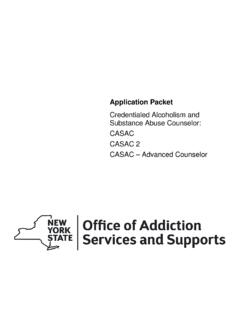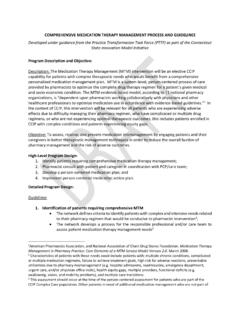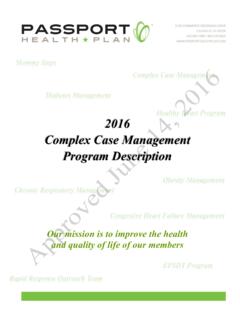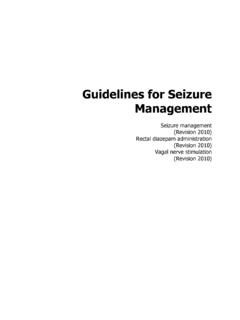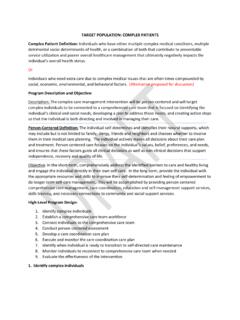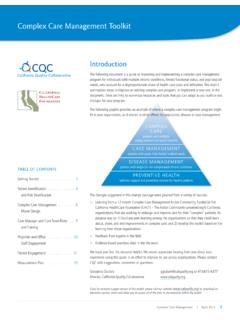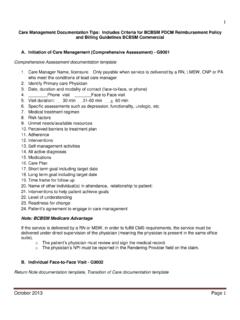Transcription of OASAS APG Medicaid Billing Guidance
1 Ambulatory Patient Groups (APG) Policy and Medicaid Billing Guidance OASAS Certified Outpatient Chemical Dependence Programs 2 APG Policy and Medicaid Billing Guidance February 2018 Table of Contents Section One Introduction .. 3 Section Two: Purpose .. 3 Section Three Elements .. 3 APG Service Categories .. 3 APG Definitions .. 4 APG Rate Codes: .. 5 APG Procedure Codes and Limitations .. 6 Section 4 Service Categories and Guidance : .. 11 APG Service Category: Screening / Brief Intervention .. 11 APG Service Category: Admission Assessment .. 12 APG Service Category: Individual Counseling .. 13 APG Service Category: Brief Treatment .. 14 APG Service Category: Group Counseling .. 15 APG Service Category: Medication Administration and Observation.
2 17 APG Service Category: Medication Management Routine .. 18 APG Service Category Medication Management Complex .. 19 APG Service Category Addiction Medication Induction/Ancillary Withdrawal .. 20 APG Service Category: Collateral Visit .. 22 APG Service Category: Complex Care Coordination .. 23 APG Service Category: Peer Advocate Services .. 24 APG Service Category: Intensive Outpatient Service (IOS) .. 25 Outpatient Rehabilitation Services .. 26 Physical Health Services .. 27 Ancillary Services .. 28 Smoking Cessation Services .. 30 Section Five General Claiming Guidelines .. 31 APG Claiming Restrictions / Limits on Payable Daily Units of Service: .. 31 Fee for Service APG Billing for Part 822 Opioid Treatment Programs.
3 31 Medicaid Managed Care Requirements for Opioid Treatment (OTP) Programs .. 32 APG Billing for Physical Health Services .. 32 Medicare / Medicaid and use of CPT codes .. 32 APG Claim Components .. 33 Fee for Service Claim Components .. 33 For Medicaid Managed Care .. 34 Section Six Tools and Resources .. 37 3 APG Policy and Medicaid Billing Guidance February 2018 Section One Introduction The Ambulatory Patient Group (APG) Billing process was implemented in July 2011 as a step-in New York State s overall effort to reform Medicaid reimbursement. In October 2015, another step of the process was begun with the implementation of Medicaid Managed Care in New York City with the Rest of the State (ROS) implementation being implemented on July 2016.
4 As part of the transition to Medicaid Managed Care, the APG Rates will be mandated until March 2020. During the transition providers in some instances will continue to bill on a fee for service basis with the APG Methodology. Medicaid Managed Care Plans must contract with an OASAS Certified Provider having five or more of the Plan s enrollees in any combination of Clinic, Outpatient Rehabilitation, or Opioid Treatment Programs (OTP). The Plan must contract with the provider for all the provider s program types. Plans must also contract with all OASAS -certified Opioid Treatment Programs in their service area, regardless on the number of Plan enrollees serve by that OTP. Each Plan has already received a list of providers that meet this contracting requirement.
5 Any OASAS provider that believes it meets the threshold requirement with a particular Plan, but who has not yet been contacted by that Plan should contact OASAS at Section Two: Purpose With both Medicaid Fee for Service and Medicaid Managed Care utilizing at least in some part the APG Methodology this manual is meant to provide the most up to date information for both types of Billing and to provide clinical Guidance in the provision of these services. This manual will provide rate codes, procedure codes and service description codes for both fee for service and managed care Billing in Outpatient SUD, Opioid Treatment Programs and Integrated Services settings. Incorporating all in one manual will assist providers as they go through this transitional process.
6 Section Three Elements APG Service Categories Screening Brief Intervention Assessment Individual Counseling Group Counseling Brief Treatment Family/Collateral Visit Peer Support Complex Care Coordination Medication Administration/Observation Medication Management Addiction Medication Induction Intensive Outpatient Services Outpatient Rehabilitation APG Definitions Clinical Staff: Staff, including licensed staff, credentialed staff, non-credentialed staff, and student interns who provide services directly to individuals. Clinical staff includes medical staff. Diagnosis: Admitted individuals must have a diagnosis of substance use disorder as given in the most recent version of the ICD or DSM. Episode of Care: For Fee for Service Outpatient Clinics, an episode is the period of time between beginning with first face-to-face service that leads to admission (to a chemical dependence outpatient treatment program) within 60 days and concluding 30 days following the discharge date.
7 For Opiate Treatment Programs, an episode is the period beginning with admission of an individual to the program and concluding every 12 months thereafter. Medical Staff: Physicians, nurse practitioners, registered physician s assistants, and registered nurses, licensed and/or certified by the State Education Department practicing within the scope of, and in accordance with, the terms and conditions of such licenses and certifications. National Provider Identifier (NPI): is a Health Insurance Portability and Accountability Act (HIPAA) Administrative Simplification Standard. The NPI is a unique identification number for covered health care providers. Covered health care providers and all health plans and health care clearinghouses must use the NPIs in the administrative and financial transactions adopted under HIPAA.
8 Prescribing Professional: Is any medical professional appropriately licensed under New York State law and registered under federal law to prescribe approved medications. Service Documentation: medical records that include a copy of the treatment plan, the name of the beneficiary, dates of services provided, nature, content and units of rehabilitation services provided, and progress made toward functional improvement and goals in the treatment plan. Components that are not provided to, or directed exclusively toward the treatment of the Medicaid beneficiary, are not eligible for Medicaid reimbursement. Telepractice: the use of two-way real-time interactive audio and video linkage system for supporting and providing certain addiction services at a distance.
9 The Part 830 Telepractice Regulations are effective on January 24, 2018. The Telepractice Standards supplement the regulations while giving Guidance on their implementation. Two service per day rule: Providers can bill for only two different services per visit date, a group and an individual. However, the following services are exempt from the two service per day rule: Medication Administration, Medicaid Management, Addiction Medication Induction, Complex Care Coordination, Visit: Means one or more services provided to an individual and/or collateral person on a single given day. 5 APG Policy and Medicaid Billing Guidance February 2018 APG Rate Codes: Outpatient Clinic/Rehab As of January 2018 As of April 2018 Type of Program Rate Code Base Rate Upstate Base Rate Downstate Base Rate Upstate Base Rate Downstate Freestanding SUD OP Clinic 1540 $ $ $ $ Freestanding SUD OP Rehab 1573 $ $ $ $ Hospital Based SUD Op Clinic 1528 $ $ $ $ Hospital Based SUD Op Rehab 1561 $ $ $ $ Physical Health Services in Outpatient Clinic/Rehab As of January 2018 As of April 2018 Type of Program Rate Code Base Rate Upstate Base Rate Downstate Base Rate Upstate Base Rate Downstate Freestanding SUD OP Clinic 1468 $ $ $ Freestanding SUD OP Rehab 1570 $ $ $ $ Hospital Based SUD Op Clinic 1552 $ $ $ $ Hospital Based SUD Op Rehab 1558 $ $ $ $ Opioid
10 Treatment Program (OTP) As of January 2018 As of April 2018 Type of Program Rate Code Base Rate Upstate Base Rate Downstate Base Rate Upstate Base Rate Downstate Freestanding OTP 1564 $ $ $ $ Hospital Based OTP 1567 $ $ $ $ 6 APG Policy and Medicaid Billing Guidance February 2018 Physical Health Services in Opioid Treatment Programs (OTP) As of January 2018 As of April 2018 Type of Program Rate Code Base Rate Upstate Base Rate Downstate Base Rate Upstate Base Rate Downstate Freestanding OTP 1471 $ $ $ $ Hospital Based OTP 1555 $ $ $ $ Integrated Outpatient Services As of January 2018 As of April 2018 Type of Program Rate Code Base Rate Upstate Base Rate Downstate Base Rate Upstate Base Rate Downstate Freestanding SUD OP Clinic 1486 $ $ $ $ Freestanding OTP 1130 $ $ $ $ Hospital Based SUD Clinic 1132 $ $ $ $ Hospital Based OTP 1134 $ $ $ $ APG Procedure Codes and Limitations The following table is a brief summary of the APG procedure codes and service limits.
